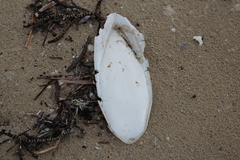The largest of all the cuttlefish and an expert at colour change and camouflage. They can change colour in an instant, and by raising parts of their skin, they can also change shape and texture to imitate rock, sand or seaweed. These displays have various interpretations to other marine creatures and may be used for camouflage, mating or even hypnotising prey.
It can be identified by two rows of three skin flap-like papillae over each eye.
Their cuttlebones can be identified by the lack of a spine and a rough V-shaped thickening (callus) at posterior end. The outer cone is wide and flared in the adult
Sorry I am working on providing identification images and information for this species please check back soon
What habitats does Sepia apama live in?
Rocky reefs, kelp forests and seagrass meadows to a depth of 100 m
What is the distribution of Sepia apama?
From Brisbane in Queensland to Shark Bay in Western Australia including Tasmania
How big does Sepia apama grow?
Can grow to a mantel length of around 50cm
Disclaimer: A lot of work goes into trying to identify and ensure accurate identifications are made and that the listed Descriptions, Sizes, Habitats and Distribution information is as accurate and valid as possible. Unfortunately, information in this arena is ever changing and as such no guarantee can be offered that it is correct or currently valid as a result the information is provided as a guide, and it is always suggested that you do a little research to ensure you have the latest and most accurate information. View the reference's or bibliography I welcome any feedback and comments on the information provided.



